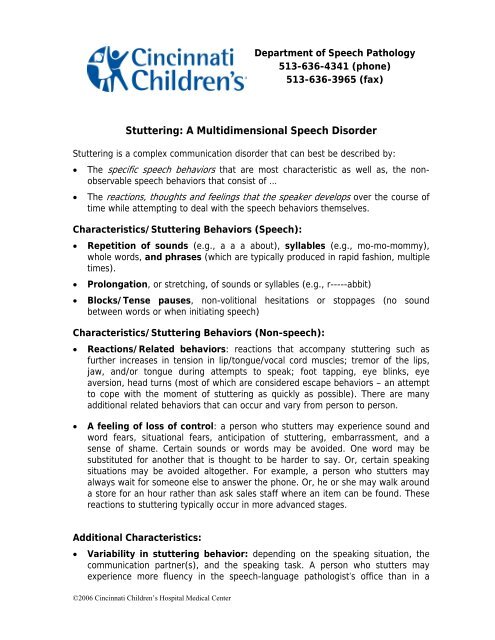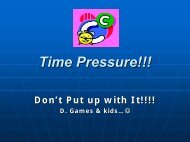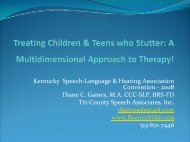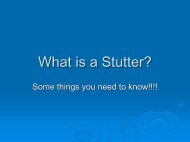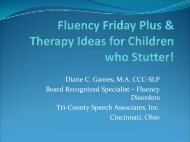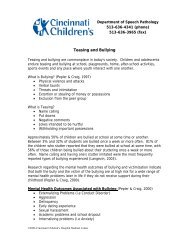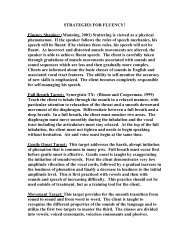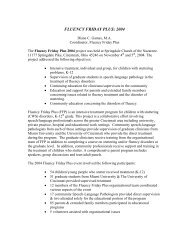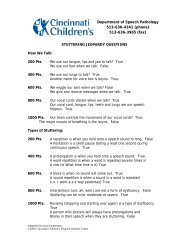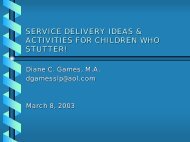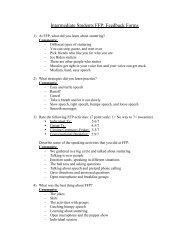Stuttering: A Multidimensional Speech Disorder - Fluency Friday Plus
Stuttering: A Multidimensional Speech Disorder - Fluency Friday Plus
Stuttering: A Multidimensional Speech Disorder - Fluency Friday Plus
Create successful ePaper yourself
Turn your PDF publications into a flip-book with our unique Google optimized e-Paper software.
Department of <strong>Speech</strong> Pathology<br />
513-636-4341 (phone)<br />
513-636-3965 (fax)<br />
<strong>Stuttering</strong>: A <strong>Multidimensional</strong> <strong>Speech</strong> <strong>Disorder</strong><br />
<strong>Stuttering</strong> is a complex communication disorder that can best be described by:<br />
• The specific speech behaviors that are most characteristic as well as, the nonobservable<br />
speech behaviors that consist of …<br />
• The reactions, thoughts and feelings that the speaker develops over the course of<br />
time while attempting to deal with the speech behaviors themselves.<br />
Characteristics/<strong>Stuttering</strong> Behaviors (<strong>Speech</strong>):<br />
• Repetition of sounds (e.g., a a a about), syllables (e.g., mo-mo-mommy),<br />
whole words, and phrases (which are typically produced in rapid fashion, multiple<br />
times).<br />
• Prolongation, or stretching, of sounds or syllables (e.g., r-----abbit)<br />
• Blocks/Tense pauses, non-volitional hesitations or stoppages (no sound<br />
between words or when initiating speech)<br />
Characteristics/<strong>Stuttering</strong> Behaviors (Non-speech):<br />
• Reactions/Related behaviors: reactions that accompany stuttering such as<br />
further increases in tension in lip/tongue/vocal cord muscles; tremor of the lips,<br />
jaw, and/or tongue during attempts to speak; foot tapping, eye blinks, eye<br />
aversion, head turns (most of which are considered escape behaviors – an attempt<br />
to cope with the moment of stuttering as quickly as possible). There are many<br />
additional related behaviors that can occur and vary from person to person.<br />
• A feeling of loss of control: a person who stutters may experience sound and<br />
word fears, situational fears, anticipation of stuttering, embarrassment, and a<br />
sense of shame. Certain sounds or words may be avoided. One word may be<br />
substituted for another that is thought to be harder to say. Or, certain speaking<br />
situations may be avoided altogether. For example, a person who stutters may<br />
always wait for someone else to answer the phone. Or, he or she may walk around<br />
a store for an hour rather than ask sales staff where an item can be found. These<br />
reactions to stuttering typically occur in more advanced stages.<br />
Additional Characteristics:<br />
• Variability in stuttering behavior: depending on the speaking situation, the<br />
communication partner(s), and the speaking task. A person who stutters may<br />
experience more fluency in the speech-language pathologist’s office than in a<br />
©2006 Cincinnati Children’s Hospital Medical Center
classroom or workplace. There may be no difficulty making a special dinner<br />
request at home, but extreme difficulty ordering a meal in a restaurant.<br />
Conversation with a spouse may be easier, and more fluent, than that with a boss.<br />
A person may be completely fluent when singing, but experience significant<br />
stuttering when talking on the telephone.<br />
• Repetitions and prolongations are considered the core features of stuttering and<br />
typically distinguish stutter behavior from “normal developmental disfluent”<br />
speech. The presence of the other listed behaviors varies from person to person<br />
and is not present in the speech of normal non-fluent speakers or developmentally<br />
disfluent children.<br />
Normal Disfluencies<br />
Every one is disfluent at times and may, under certain circumstances, demonstrate<br />
repetitions and/or prolongations while speaking. However, the disfluencies of people<br />
who do not stutter are not as frequent as those who do, and are not associated with<br />
any degree of negative feeling or thinking about speech or communication in general.<br />
The kind of disfluencies are also generally different as well, although children who do<br />
not develop stuttering may also evidence stutter behaviors in their speech for a<br />
period of time during their development.<br />
Normal disfluencies tend to be repetitions of whole words, phrases, or the interjection<br />
of syllables like um and er. Repetitions are typically not longer than 1 iteration and are<br />
not associated with any degree of tension or rate change.<br />
Disfluencies in Children<br />
Most children go through a stage of disfluency in early speech development, usually<br />
between the ages of 2 ½ and 5. <strong>Speech</strong> is produced easily in spite of the disfluencies.<br />
Then as children mature and sharpen their communication skills these disfluencies<br />
typically disappear. In some children normal disfluencies may be present alone, while<br />
in others, these kinds of disfluencies may co-occur along with stutter behavior. While<br />
it is difficult to determine which children who demonstrate early stutter behavior will<br />
ultimately recover, there are some definite guidelines that are considered important<br />
when making decisions regarding interventions.<br />
Identifying children who are at risk vs. normal disfluencies.<br />
The child at risk for stuttering:<br />
• May have a family history of stuttering.<br />
• May have other speech and language deficits along with the speech breakdown.<br />
• Began demonstrating stutter behavior after 3 years of age.<br />
• Repeats parts of words, either sounds or syllables ("t-t-table", "ta-ta-ta-table");<br />
prolongs a sound ("sssun"); or breaks up words ("cow - boy"or has difficulty<br />
©2006 Cincinnati Children’s Hospital Medical Center
initiating - opens the mouth to speak but no sound comes out or turns off the<br />
voice between sound repetitions)<br />
• Often repeats part of the word multiple times ("ta-ta-ta-table) although some<br />
reports indicate that these children may repeat only 1 or 2 times<br />
• During repetitions, substitutes an "uh" vowel for the intended vowel in the word<br />
("tuh-tuh-tuh-table" rather than “ta-ta-ta-table”).<br />
• May use a broken rhythm during repetitions ("b b& & b boy")<br />
• Has 10 or more total disfluencies every 100 words of which more than 3 are<br />
considered stutter-like behavior.<br />
The child with normal disfluency:<br />
• Will repeat whole words or phrases ("I-I-I want to - want to go out and play.")<br />
• Typically repeats parts of the word no more than 1 or 2 times ("ta-table")<br />
• During repetitions, uses the vowel sound normally found in the word ("ta-table")<br />
• Has rhythmic repetitions ("b ..b ..boy")<br />
• Has 9 or less total disfluencies every 100 words<br />
• Starts speech easily; keeps speech going even though may repeat a phrase or<br />
word later in the sentence<br />
<strong>Stuttering</strong> and developmental disfluent behavior usually emerges during the same<br />
time period and are less likely to begin after age 5. On occasion stutter behavior may<br />
appear for the first time in a school-age child and, far more rarely, in an adult. As a<br />
parent, seek the advice of an ASHA-certified speech-language pathologist if:<br />
• You or your child are concerned about his or her speech<br />
• Disfluencies begin to occur more regularly<br />
• Occurs with greater frequency over time<br />
• Disfluencies begin to sound effortful or forced.<br />
• Airflow for speech is started before any other muscle movement is observable.<br />
©2006 Cincinnati Children’s Hospital Medical Center


